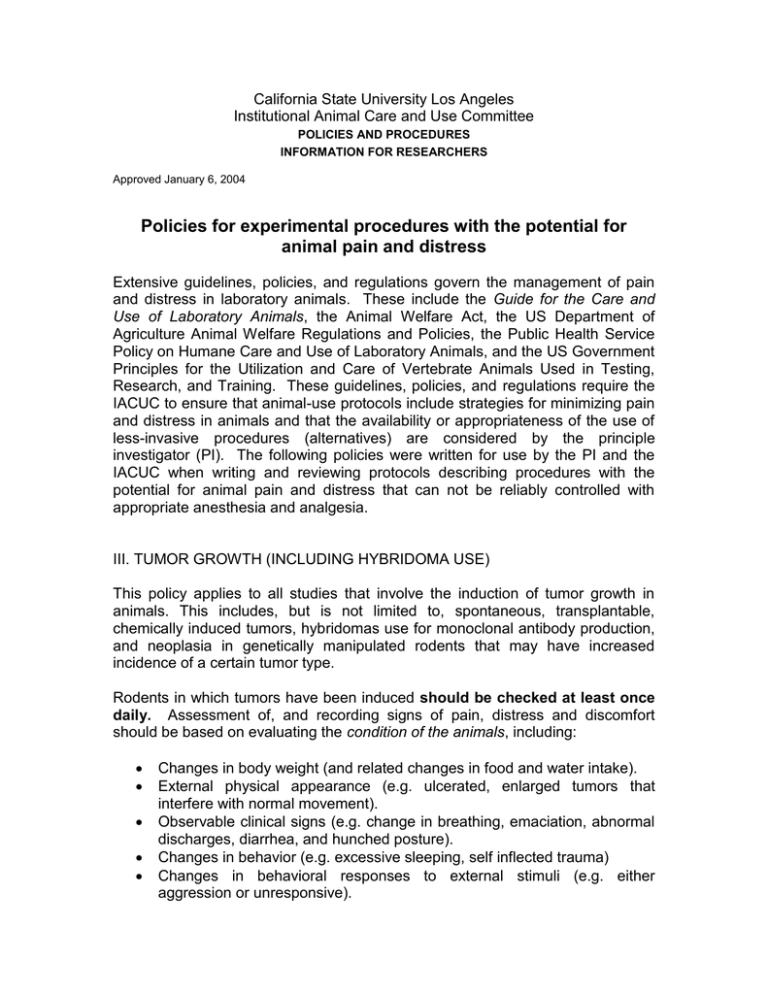Guidelines for Production of Antibodies
advertisement

California State University Los Angeles Institutional Animal Care and Use Committee POLICIES AND PROCEDURES INFORMATION FOR RESEARCHERS Approved January 6, 2004 Policies for experimental procedures with the potential for animal pain and distress Extensive guidelines, policies, and regulations govern the management of pain and distress in laboratory animals. These include the Guide for the Care and Use of Laboratory Animals, the Animal Welfare Act, the US Department of Agriculture Animal Welfare Regulations and Policies, the Public Health Service Policy on Humane Care and Use of Laboratory Animals, and the US Government Principles for the Utilization and Care of Vertebrate Animals Used in Testing, Research, and Training. These guidelines, policies, and regulations require the IACUC to ensure that animal-use protocols include strategies for minimizing pain and distress in animals and that the availability or appropriateness of the use of less-invasive procedures (alternatives) are considered by the principle investigator (PI). The following policies were written for use by the PI and the IACUC when writing and reviewing protocols describing procedures with the potential for animal pain and distress that can not be reliably controlled with appropriate anesthesia and analgesia. III. TUMOR GROWTH (INCLUDING HYBRIDOMA USE) This policy applies to all studies that involve the induction of tumor growth in animals. This includes, but is not limited to, spontaneous, transplantable, chemically induced tumors, hybridomas use for monoclonal antibody production, and neoplasia in genetically manipulated rodents that may have increased incidence of a certain tumor type. Rodents in which tumors have been induced should be checked at least once daily. Assessment of, and recording signs of pain, distress and discomfort should be based on evaluating the condition of the animals, including: Changes in body weight (and related changes in food and water intake). External physical appearance (e.g. ulcerated, enlarged tumors that interfere with normal movement). Observable clinical signs (e.g. change in breathing, emaciation, abnormal discharges, diarrhea, and hunched posture). Changes in behavior (e.g. excessive sleeping, self inflected trauma) Changes in behavioral responses to external stimuli (e.g. either aggression or unresponsive). The Principal Investigator should clearly define endpoints for experiments involving tumor growth. The use of survival time as an endpoint is not acceptable. The PI should also define a set of conditions under which the affected animals will be euthanized prematurely (due to declining health and well being of the animal; examples are included below). Animals should be euthanized before their tumor burden becomes excessive and before the animals become debilitated. The following criteria are examples of conditions for which animals will be euthanized when involved in a tumor study; these criteria should be incorporated into the animal use protocol form submitted to the IACUC: An ulcerated tumor, regardless of tumor size or weight. Tumor burden exceeding 10% of body weight. (10% typically represents a subcutaneous nodule of 1.5 cm in a 25 gm mouse or 2.5 cm in a 250 gm rat). Animals that are moribund or unable to move or failure to respond to gentle stimuli. Labored breathing- particularly if accompanied by nasal discharge and/or cyanosis. Diarrhea or incontinence. Inability to eat and drink. Weight loss exceeding 20% of the body weight (the tumor mass should not be included in the calculation). If animals are seen to be in distress, regardless tumor size or weight. For animals on studies involving monoclonal antibody production by ascites (hybridoma) methods, the recommendations of the National Research Council special committee on monoclonal antibody production (available at http://www.health.gov.au/nhmrc/research/awc/monosyn.htm) should be followed. In addition to the requirements for monitoring and endpoints listed above for all tumors, investigators must provide the IACUC with specific justification for using ascites-inducing tumors in mice instead of in vitro culture methods for monoclonal antibody production. Wherever possible, in vitro methods should be adopted as the routine method unless there is a clear reason why their use would present an unreasonable barrier to obtaining the needed product at a cost consistent with the realities of available research funding. In addition to this justification, investigators will be approved for only one tap of ascites as a terminal procedure once sufficient fluid has collected in the abdomen of the animal.



